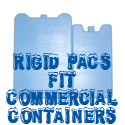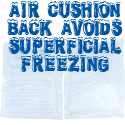Introduction Temperature-sensitive products, such as chilled and frozen foods, live seafood, pharmaceuticals, biotechnological products and electronics, require thermal protection during their entire supply chain. This protection is often accomplished by the use of active cooling systems, such as refrigerated transport. However, there can be instances where the energy supply required to drive refrigerated equipment is […]
Products | How Gel Ice Works
2. Components of an insulated transport packaging system
Typically, insulated shipping containers encompass: (a) An external cardboard box. This box presents the product logo, labels and shipping information. It also adds an extra-layer for thermal protection, adds physical strength to the package, and allows palletisation of several packages for transportation and storage. (b) Thermal insulation. Insulation protects the product against transmission of heat […]
3. How does an insulated transport package protect temperature-sensitive products?
The figure at right shows the different sources of heat that can affect the packaged product and the thermal protection offered by the different layers of the insulated package. FIGURE: Cut-view of an insulated shipping package that shows the sources of heat transmission to the product and the different packaging layers that offer thermal protection. […]
4. Products that benefit from insulated transport packaging
A wide range of products need to be transported at low temperatures, including: • Live, chilled and frozen seafood. • Fresh produce and dairy products. • Temperature-sensitive pharmaceuticals. • Blood and blood products. • Other biological products. • Some industrial adhesives. • Gyroscopes and other scientific instruments. • Some electronic devices and components. The ANZ […]
5. Products that benefit from insulated transport packaging
How can I ensure that my insulated package has enough cooling and insulation? The design of an insulated shipping package needs to strike a balance between optimum thermal protection and cost. If the package fails to maintain foods or vaccines temperatures in the appropriate range, there can be catastrophic consequences for the consumer (e.g. food […]
6. References
Anon, 1999. The Australian Cold Chain Guidelines: For the handling, storage and transport of frozen foods, ice cream and chilled foods for retail sale and in food service outlets. Published by the Australian Food and Grocery Council, the Australian Supermarket Institute and the Refrigerated Warehouse and Transport Association. 39 pp. Anon, 2000. General notices: storage […]
7. Useful Links
www.foodstandards.gov.au/ The website of Food standards Australia New Zealand. Working within an integrated food regulatory system involving the governments of Australia and the New Zealand Government, FSANZ sets food standards for the two countries. Regulatory guidelines for the manufacture, handling, transport, retail and storage of foods can be found here. www.ista.org/ The website of the […]







